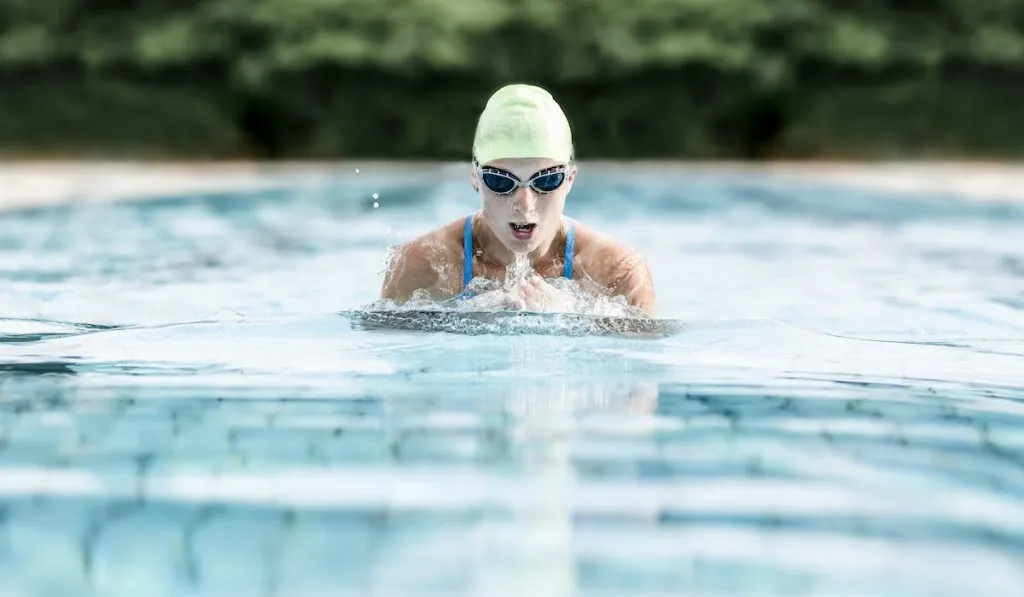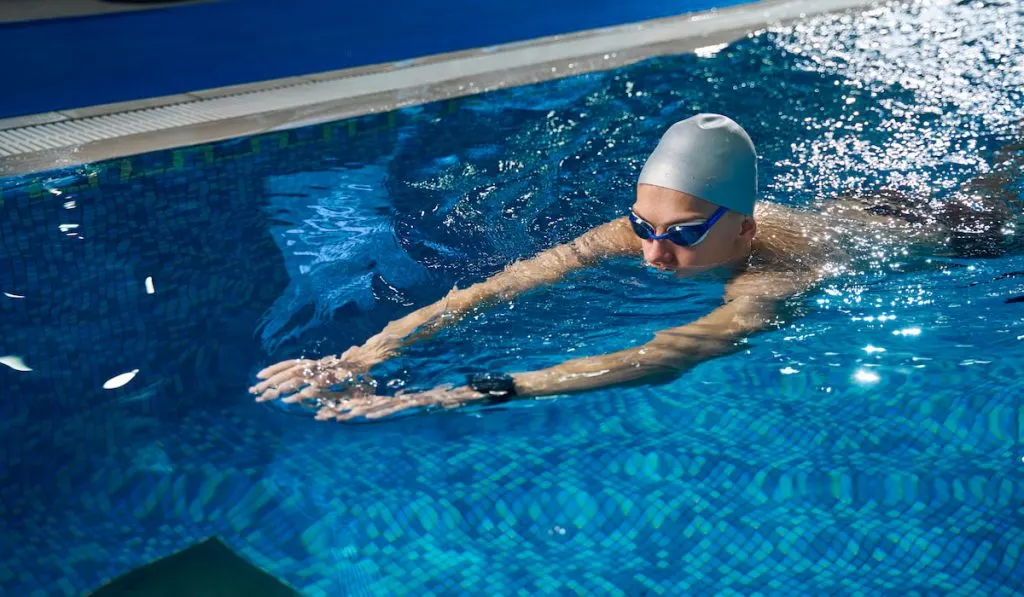When doing regular breaststroke, your head stays in line with your trunk the whole time. So, when your torso goes underwater, your head goes underwater too.
But can you swim the breaststroke with your head above water?
Swimming breaststroke with your head above water is pretty handy for recreational swimming. For one, it keeps your hair largely dry, so you don’t have to wear a swim cap.
If you haven’t quite gotten the hang of swimming breaststroke with your head up, we’ve got a guide for you. Below, we talk about how to swim breaststroke with your head above water. We’ll also compare this style of breaststroke to regular breaststroke, so read on and enjoy.

How to Swim Breaststroke With Your Head Above Water
With the gliding phase as your starting point, the following steps highlight how to swim breaststroke with your head above water:
- Get into the water and take on the horizontal gliding position. Extend your arms forward and keep your legs close together with your toes pointed. Then raise your head above water while your chest stays inclined in the water.
- Next, sweep your arms outward and backward. At the same time, kick your legs outward and backward to push your hips towards the surface of the water and propel your body. Do this while keeping your head above water and your chest inclined.
- Then sweep your arms inward and forward, moving your hands towards each other as you propel your body. At the same time, move your legs inward and forward to bring them close to each other. While you do this, keep your head above water and your chest inclined.
- When your arms and legs are fully extended, you will be in the starting horizontal position again. Glide in this position for a few seconds before starting another stroke cycle (steps 1 and 3).

Tips for Swimming Breaststroke With Head Above Water
When doing the breaststroke with your head above water, the following tips can help enhance your performance:
- Always keep your hands in front of you and ahead of your elbows.
- Let your mouth and chin go underwater, leaving your nostrils above water so you can breathe.
- Sink the end of your back well into the water, so you are not fully horizontal but semi-vertical.
- Be patient and take your time.
Incorporating the tips above into your technique while swimming breaststroke with your head above the water will help keep your neck relaxed.
As a result, there will be less stress on your neck and spine, and your movement will be less inhibited.
Also, you won’t have to sweep your arms as powerfully as you would without these tips.

Benefits of Swimming Breaststroke With Your Head Above Water
People do breaststroke with their head above water for the following reasons:
- Swimming breaststroke with your head up allows you to breathe freely.
- The head-up breaststroke makes it possible to enjoy the scenery when swimming outdoors.
- While swimming breaststroke with your head above water, you can easily navigate the water.
- You can communicate with the people around you while doing head-up breaststroke.
- You do not have to put your face in the water while doing head-up breaststroke.
- When doing head-up breaststroke, you do not have to wear goggles. So, if you have no goggles or do not want to wear them, you can swim breaststroke with your head above water.
- Swimming breaststroke with your head above water is not as energy-consuming as the butterfly or freestyle stroke.
- When you swim breaststroke with your head above water, you can keep your hair mostly dry with proper care.

Downsides of Swimming Breaststroke With Your Head Above Water
Swimming breaststroke with your head above water is not perfect; the following are some downsides that come with the technique:
- The primary disadvantage of swimming breaststroke with your head above water is neck strain. Having to raise your neck and point your chin forward while doing breaststroke puts a lot of pressure on your neck.
- You may also strain your neck if you sweep your arm intensely or hold your pelvis up too much to stay horizontal.
- Since your head does not stay in line with your torso while doing the head-up breaststroke, your body creates significant drag. As a result, you may not be able to swim as fast.

Regular Breaststroke vs. Head-Up Breaststroke
| Regular Breaststroke | Head-Up Breaststroke | |
| Position | In regular breaststroke, your head stays in line with your torso. | When doing the head-up breaststroke, your head stays raised while you incline your chest underwater. |
| Breathing | When doing the regular breaststroke, you take quick breaths when your mouth is clear of the water. | Your nose is above water, so you can breathe normally. |
| Speed | With the head and torso in line, you will experience minimal drag. So, you can swim faster. | With the head raised and the torso inclined, there will be significant drag. Consequently, your swimming speed may drop. |
| Strain | The risk of neck and spine strain is minimal or relatively lower. | There is a good chance you will strain your neck and spine. |
Summary
Swimming breaststroke with your head above water is basically doing breaststroke with your chest inclined and your head above water. The technique allows you to breathe freely and keep your hair dry while keeping your face out of cold water. However, it will put a lot of strain on your neck and possibly, your spine.
